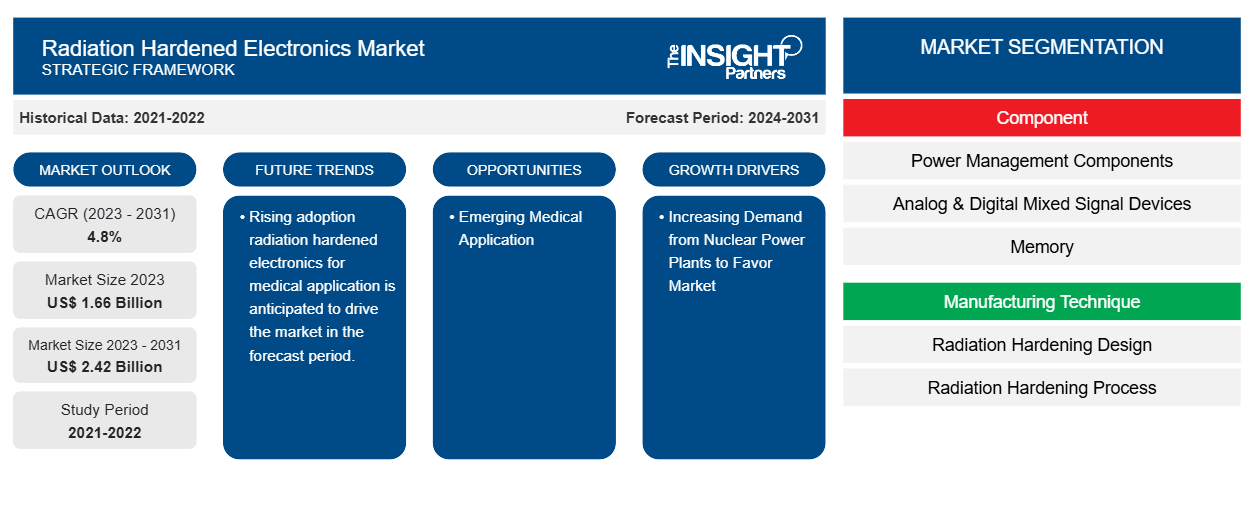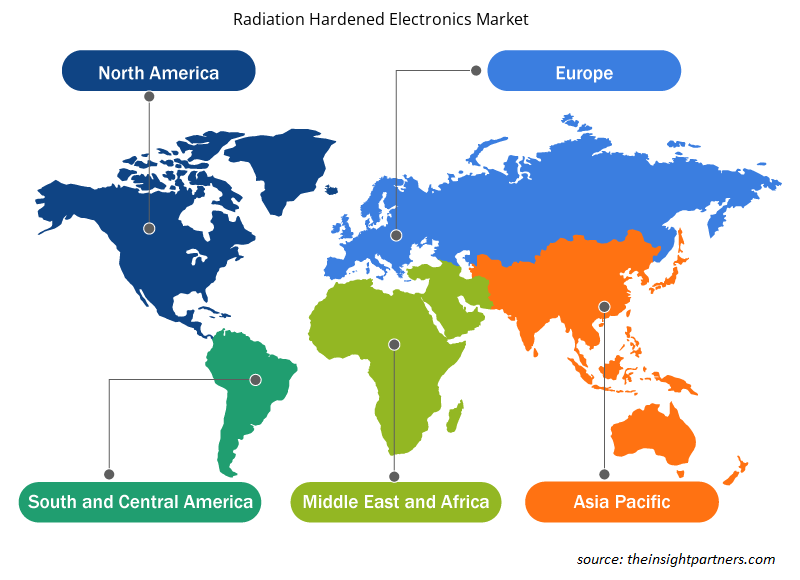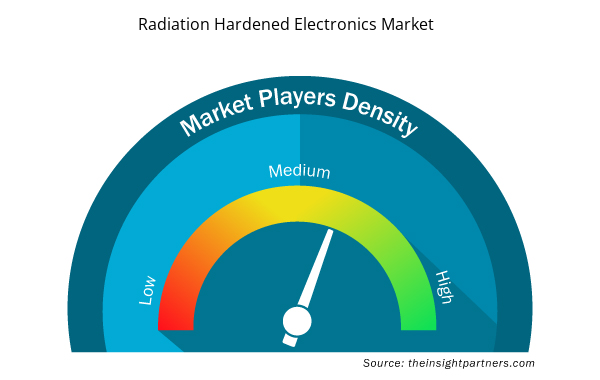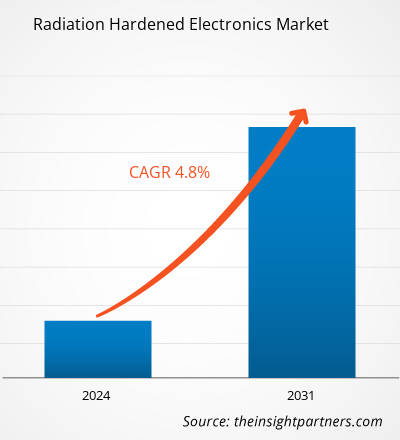The Radiation Hardened Electronics market size is projected to reach US$ 2.42 billion by 2031 from US$ 1.66 billion in 2023. The market is expected to register a CAGR of 4.8% during 2023–2031. Increasing adoption of radiation-hardened electronics and increasing investment in space programs are likely to remain key trends and drivers in the market.
Radiation Hardened Electronics Market Analysis
Growing demand for radiation hardened feedback sensors among critical equipment and system manufacturers across the globe is expected to boost the radiation hardened feedback sensors market during the forecast period. Radiation hardened feedback sensors are widely integrated into aerospace & defense systems, spacecraft, satellites, space probes, medical equipment, and others. Technological advancements, miniaturization of radiation hardened feedback sensors, rising demand for renewable energy, and increasing R&D activities are propelling the radiation hardened feedback sensors market.
Radiation Hardened Electronics Market Overview
Radiation hardened feedback sensors are devices designed to withstand high levels of radiation, most commonly encountered in nuclear and space environments. These sensors employ a feedback mechanism for continuously monitoring their performance and adjust accordingly by ensuring reliable and accurate operations in hard radiations. The sensors utilize feedback loops to detect any deviations from their expected behavior caused by radiation-induced damage.
Customize This Report To Suit Your Requirement
You will get customization on any report - free of charge - including parts of this report, or country-level analysis, Excel Data pack, as well as avail great offers and discounts for start-ups & universities
Radiation Hardened Electronics Market: Strategic Insights

- Get Top Key Market Trends of this report.This FREE sample will include data analysis, ranging from market trends to estimates and forecasts.
You will get customization on any report - free of charge - including parts of this report, or country-level analysis, Excel Data pack, as well as avail great offers and discounts for start-ups & universities
Radiation Hardened Electronics Market: Strategic Insights

- Get Top Key Market Trends of this report.This FREE sample will include data analysis, ranging from market trends to estimates and forecasts.
Radiation Hardened Electronics Market Drivers and Opportunities
Increasing Demand from Nuclear Power Plants to Favor Market
Nuclear power plants are involved in generating electricity through the process of nuclear fission. In this process, a significant amount of power is produced, which generates a substantial amount of radiation. This radiation is harmful to humans and can damage electronic equipment, increasing the demand for radiation hardened feedback sensors. Radiation hardened feedback sensors are strategically placed throughout the plant to monitor temperature variations in critical areas, such as the coolant systems, reactor core, and various components. These sensors provide continuous feedback to the control systems, enabling plant operators to take necessary actions for maintaining the desired temperature range and make informed decisions to improve the system’s performance. Several companies are making significant investments in developing power plants. For instance, according to the US Department of Energy (DOE) data published in January 2024, the DOE invested ~US$ 12 billion in Plant Vogtle to provide more than 1,100 megawatts of clean power to the grid once in operation.
Emerging Medical Application.
Radiation hardened feedback sensors play a crucial role in ensuring the safety, accuracy, and reliability of medical equipment used in the healthcare industry. These sensors are integrated into a variety of medical equipment, including gamma rays, X-rays, and electron beams, by making them withstand high levels of radiation. Radiation hardened feedback sensors are primarily integrated into radiation therapy equipment to support doctors in treating cancer patients. Radiation therapy, also known as radiotherapy, is the most common treatment mode for cancer patients, where high-energy radiation beams are used to target and destroy cancerous cells, which require radiation hardened feedback sensors to monitor various parameters, including dose delivery, beam density, and beam positioning. Healthcare professionals use radiation hardened feedback sensors to ensure the delivery of accurate and precise treatment by minimizing damage to healthy tissues. For instance, in April 2022, Maxon Group introduced ENX GAMA encoders designed for use in the vicinity of medical linear accelerators on equipment such as multi-leaf collimators. ENX GAMA encoders are radiation-resistant encoders integrated with DC motors that are highly suitable for radiotherapy devices.
Radiation Hardened Electronics Market Report Segmentation Analysis
Key segments that contributed to the derivation of the radiation hardened electronics market analysis are component, manufacturing technique, and applications.
- Based on component, the radiation hardened electronics market is divided into power management components, analog & digital mixed signal devices, memory, and controllers & processors. The power management components segment is anticipated to hold a significant market share in the forecast period.
- Based on manufacturing technique, the radiation hardened electronics market is divided into radiation hardening by design (RHBD) and radiation hardening by process (RHBP). The radiation hardening by design (RHBD) segment is anticipated to hold a significant market share in the forecast period.
- By applications, the market is segmented into aerospace & defense, nuclear power plant, space, and others. The aerospace & defense is anticipated to hold a significant market share in the forecast period.
Radiation Hardened Electronics Market Share Analysis by Geography
The geographic scope of the radiation hardened electronics market report is mainly divided into five regions: North America, Asia Pacific, Europe, Middle East & Africa, and South & Central America.
North America has dominated the radiation hardened electronics market. The expanding space industry is boosting the radiation hardened feedback sensors market in North America. The US has been at the forefront of spaceflight for more than 60 years. It has the world's largest government space program. The US-registered satellites accounted for more than half of all operational satellites in 2022. The US is currently the only country with a thematic account for space activities. Moreover, a strong emphasis on research and development in the developed economies of the US and Canada is forcing the North American players to bring technologically advanced solutions into the market. In addition, the US has a large number of radiation hardened electronics market players who have been increasingly focusing on developing innovative solutions. All these factors contribute to the region's growth of the radiation hardened electronics market.
Radiation Hardened Electronics Market Regional Insights
The regional trends and factors influencing the Radiation Hardened Electronics Market throughout the forecast period have been thoroughly explained by the analysts at Insight Partners. This section also discusses Radiation Hardened Electronics Market segments and geography across North America, Europe, Asia Pacific, Middle East and Africa, and South and Central America.

- Get the Regional Specific Data for Radiation Hardened Electronics Market
Radiation Hardened Electronics Market Report Scope
| Report Attribute | Details |
|---|---|
| Market size in 2023 | US$ 1.66 Billion |
| Market Size by 2031 | US$ 2.42 Billion |
| Global CAGR (2023 - 2031) | 4.8% |
| Historical Data | 2021-2022 |
| Forecast period | 2024-2031 |
| Segments Covered |
By Component
|
| Regions and Countries Covered | North America
|
| Market leaders and key company profiles |
Radiation Hardened Electronics Market Players Density: Understanding Its Impact on Business Dynamics
The Radiation Hardened Electronics Market is growing rapidly, driven by increasing end-user demand due to factors such as evolving consumer preferences, technological advancements, and greater awareness of the product's benefits. As demand rises, businesses are expanding their offerings, innovating to meet consumer needs, and capitalizing on emerging trends, which further fuels market growth.
Market players density refers to the distribution of firms or companies operating within a particular market or industry. It indicates how many competitors (market players) are present in a given market space relative to its size or total market value.
Major Companies operating in the Radiation Hardened Electronics Market are:
- BAE Systems
- Data Device Corporation
- Honeywell International Inc.
- Infineon Technologies AG
- Renesas Electronics Corporation
- Texas Instruments Incorporated
Disclaimer: The companies listed above are not ranked in any particular order.

- Get the Radiation Hardened Electronics Market top key players overview
Radiation Hardened Electronics Market News and Recent Developments
The radiation hardened electronics market is evaluated by gathering qualitative and quantitative data post primary and secondary research, which includes important corporate publications, association data, and databases. A few of the developments in the radiation hardened electronics market are listed below:
- EPC Space introduced the EPC7009L16SH, a radiation hardened gallium nitride (GaN) gate driver IC. Utilizing EPC’s exclusive eGaN IC technology, this innovative GaN driver empowers design engineers to fully exploit the capabilities of eGaN FET technology. (Source: EPC Space, Company Website, April 2024)
- Renesas Electronics Corporation, a supplier of advanced semiconductor solutions, launched a new line of plastic-packaged radiation-hardened (rad-hard) devices for satellite power management systems. The four new devices include the ISL71001SLHM/SEHM point of load (POL) buck regulator, ISL71610SLHM and ISL71710SLHM digital isolators, and the ISL73033SLHM 100V GaN FET and integrated low-side driver. (Source: Renesas Electronics Corporation, Company Website, July 2021)
Radiation Hardened Electronics Market Report Coverage and Deliverables
The “Radiation Hardened Electronics Market Size and Forecast (2021–2031)” report provides a detailed analysis of the market covering below areas:
- Radiation hardened electronics market size and forecast at global, regional, and country levels for all the key market segments covered under the scope.
- Radiation hardened electronics market trends as well as market dynamics such as drivers, restraints, and key opportunities.
- Detailed PEST/Porter’s Five Forces and SWOT analysis.
- Radiation hardened electronics market analysis covering key market trends, global and regional framework, major players, regulations, and recent market developments.
- Industry landscape and competition analysis covering market concentration, heat map analysis, prominent players, and recent developments for the Radiation hardened electronics market.
- Detailed company profiles.
- Historical Analysis (2 Years), Base Year, Forecast (7 Years) with CAGR
- PEST and SWOT Analysis
- Market Size Value / Volume - Global, Regional, Country
- Industry and Competitive Landscape
- Excel Dataset



Report Coverage
Revenue forecast, Company Analysis, Industry landscape, Growth factors, and Trends

Segment Covered
Component, Manufacturing Technique, and Application

Regional Scope
North America, Europe, Asia Pacific, Middle East & Africa, South & Central America

Country Scope
Australia, Brazil, Canada, China, France, Germany, India, Italy, Japan, Mexico, Russian Federation, Saudi Arabia, South Africa, South Korea, United Arab Emirates, United Kingdom, United States
Frequently Asked Questions
Which region dominated the radiation hardened electronics market in 2023?
North America is anticipated to dominate the radiation hardened electronics market in 2023.
What are the driving factors impacting the radiation hardened electronics market?
Increasing adoption of radiation-hardened electronics and increasing investment in space program are some of the factors driving the radiation hardened electronics market.
What are the future trends of the radiation hardened electronics market?
Rising adoption radiation hardened electronics for medical application is anticipated to drive the market in the forecast period.
Which are the leading players operating in the radiation hardened electronics market?
The key players holding majority shares in the global radiation hardened electronics market are BAE Systems, Data Device Corporation, Honeywell International Inc., Infineon Technologies AG, Renesas Electronics Corporation, Texas Instruments Incorporated, STMicroelectronics, Xilinx; Inc. (AMD), VORAGO Technologies, Microchip Technology Inc.
What would be the estimated value of the radiation hardened electronics market by 2031?
The global radiation hardened electronics market is expected to reach US$ 2.42 billion by 2031.
What is the expected CAGR of the radiation hardened electronics market?
The expected CAGR of the radiation hardened electronics market is 4.8%.

 Get Free Sample For
Get Free Sample For